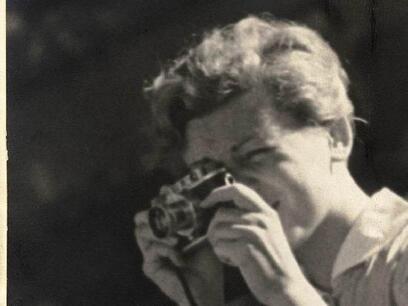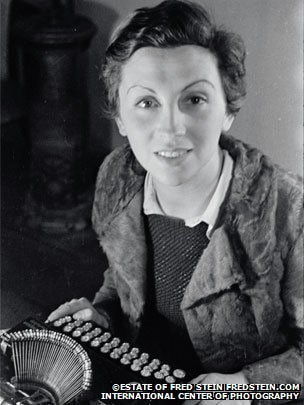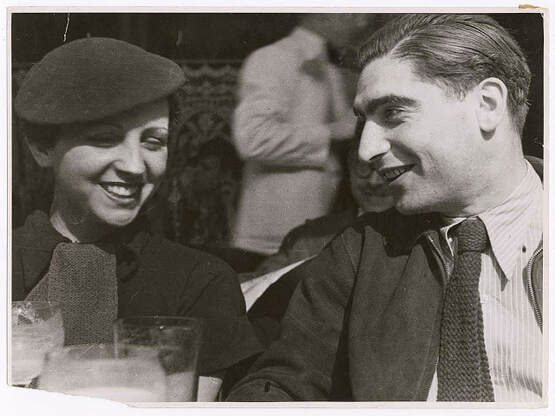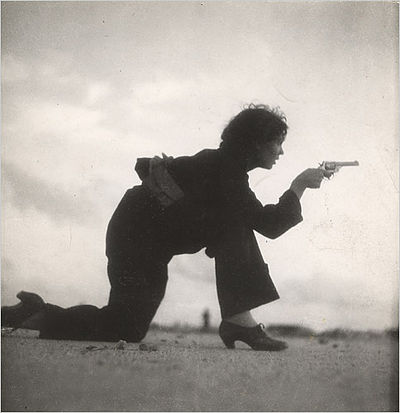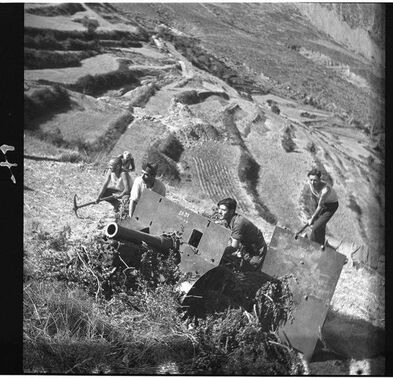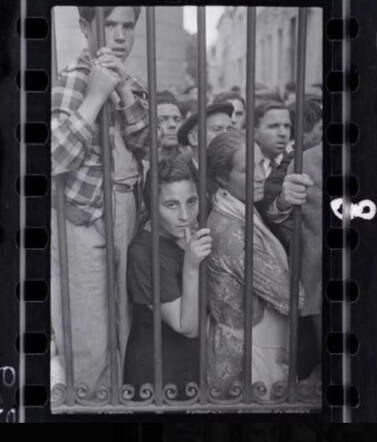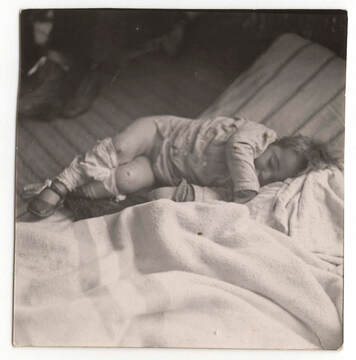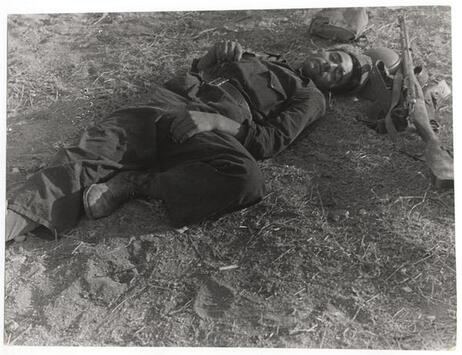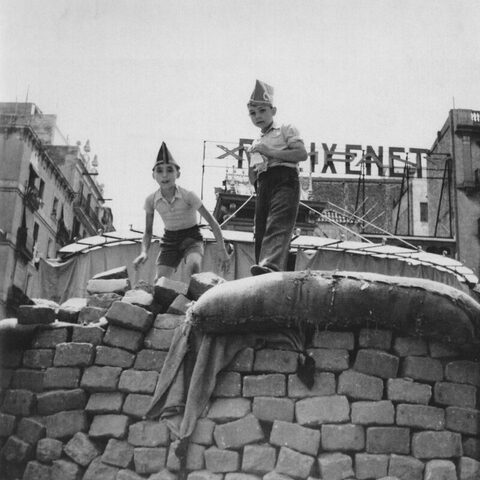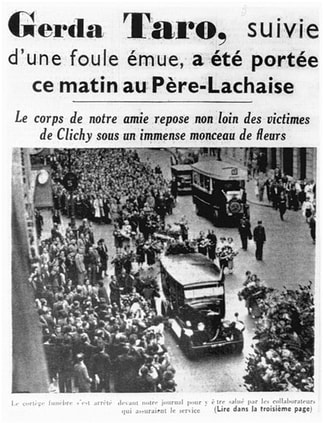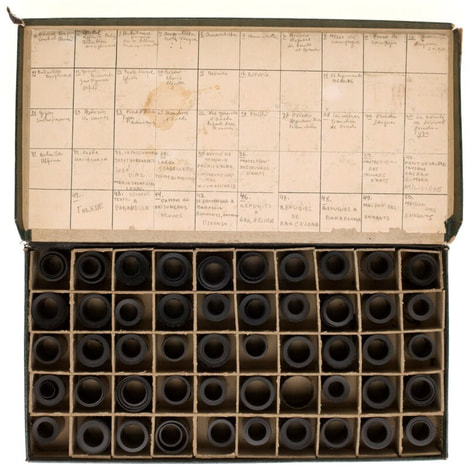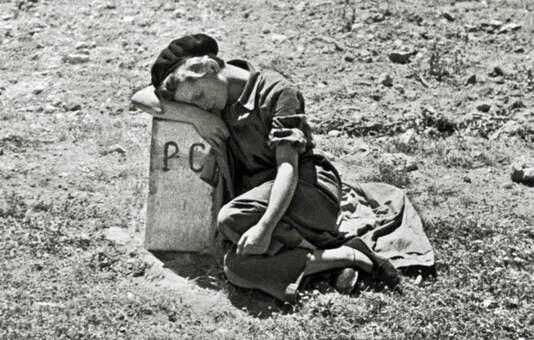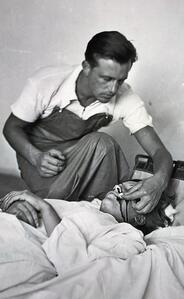|
This week's feature story could be filed under tragic love stories. But I'm not focusing on the couple. This story is about the woman who is often stuck in a forgotten corner of history, hidden by the long shadow cast by her famous lover. Gerda Taro believed photographs could change the world. In the mid-1930s, she served as a midwife of sorts, helping birth the powerful force of modern photo journalism. Taro captured some of the most memorable images of the Spanish civil war, and was the first woman in history to take pictures in battle. Unfortunately, she was also the first to lose her life reporting in a war zone. Tragedy and mystery conspired to shroud Gerda Taro and her work, leaving photojournalism to move on without her. Below: Gerda Taro at work. The daring activism that carried Gerda to the battlefields of Spain ignited in Germany. Gerda Pohorylle was born in 1910 to a Jewish family in Stuttgart. She came of age with the rising fascist National Socialists German Workers Party, (Nationalsozialistische Deutsche Arbeiterpartei abbreviated Nazi) and joined the opposition. In 1933, while passing out pamphlets at an anti-Nazi protest, Gerda was arrested and detained. Hitler became chancellor shortly after, and 23-year-old Gerda fled to Paris for safety. Amid a a flood of refugees fleeing fascism, Gerda struggled to find work in Paris, but eventually got a job at Alliance Photo Agency. Hanging out with other young newcomers to Paris, she met Endré Friedmann, a Hungarian refugee trying to make a living as a photographer. The two fell in love and developed a remarkable working relationship. Gerda advised Endré on aspects of business and wrote captions for his pictures. He taught her the fundamentals of photography. But it seemed impossible to rise from poverty and obscurity. As Paris overtook Berlin as the capital of modern photojournalism, competition for work and recognition intensified. Gerda and Endré's last names did not help them. Pohorylle and Friedmann immediately labeled them as immigrants and Jews. Gerda suggested they change their names and reinvent themselves. She attributed her photos to Gerda Taro, and helped Friedmann cast himself as Robert Capa, a wealthy American, recent arrival in Europe, and a successful photographer. True enough, Gerda sold Robert Capa’s work for three times the money of Endré Friedmann’s. Within a year Gerda started selling her own pictures as well as Robert's, and they lived quite well. Gerda refused Robert's proposal for marriage, but that did not break up the relationship. While building their professional skill and reputation, Gerda Tara and Robert Capa remained acutely aware of the tide of fascism in Germany and Italy. When a group of right-wing generals staged a military coup in Spain, in July, 1936, the couple immediately flew to Barcelona on assignment for a French news magazine. One of their first stories documented a group of militiawomen, who were members of the Unified Socialist Party of Catalonia (the Catalan branch of the Communist Party of Spain), training on a nearby beach. The photo below was taken by Gerda Taro. Reporting from previous war zones, photographers took their pictures before or after a battle, but Capa and Taro got right in the action. They embedded with the fighters and ran through gunfire to get their photos. Siding with the Republican's, Capa and Taro focused on the Loyalist troops trying to put down Franco's rebel army. When working together, often their photos were published under Capa's byline, perhaps to sidestep those prejudiced against women in the profession. Then in Spain Taro emerged as a photojournalist in her own right, her pictures published around the world. Gerda was fearless, compelled to experience the conflict first-hand. She took thousands of photographs, seeking to capture the fervor of battle experienced by the fighters and also that of refugees and citizens caught in the violence. Early on, the rebel Nationalists repeatedly bombed the crucial shipping port of Valencia, but on May 15, 1937, they adopted a new strategy. Aided by the Italian air force, they attacked the city, indiscriminately bombing civilians to spread panic and terror. Gerda reported on the bombing in Valencia by herself on contract with the French communist newspaper Ce Soir. One of her most famous photos showed families pressed against the gates of the morgue waiting for news of loved ones. Taro then went into the morgue to photograph the bodies lying on tables and the floor. This type of carnage would become all to familiar in WWII, but in 1937, this purposeful bombing of civilians was a new level of warfare. Taro desperately wanted to show the world what was happening in Spain, but some faulted her and Capa for not being objective journalists. “We all loved Gerda very much,” wrote Alexander Szurek, an adjutant to a Spanish Republican general, in his memoirs. “Gerda was petite with the charm and beauty of a child. This little girl was brave and the Division admired her for that...[She] was so passionate about the suffering of the Spanish people. “She got too involved, became a star reporter and over identified with the republican cause. But she got into this conviction that she had to bear witness," says her biographer Jane Rogoyska. "The troops loved her and she kept pushing. Capa warned her not to take so many risks.” In the spring and early summer of 1937, Taro covered the Brunete area near Madrid for Ce Soir. Franco's troops announced they had seized control of the region, but pockets of Loyalists were still fighting, and they gained command, forcing the Nationalists to retreat. Taro’s photographs were the only proof this was happening. Then in late July, General Franco's troops retook the town of Brunete, inflicting heavy losses on the Republicans' best troops who were now retreating under fire. Taro stayed with them, snapping photographs as bombs fell and planes strafed the ground with machine-gun fire. Eventually, Gerda ran out of film and headed for a safe position. "She was elated, saying 'I've got these fantastic photographs, I've got champagne, we're going to have a party,'" says Jane Rogoyska. Gerda hitched a ride on the running board of a general's car evacuating wounded soldiers. Near Villanueva de la Cañada, German aircraft supporting Franco's army flew over and strafed the retreating company. A loyalist army tank lost control and crashed into the general's vehicle. Gerda suffered serious injuries. She was alive and conscious when she arrived at the British Hospital in El Escorial fifteen miles away, where New Zealand surgeon Dr. Douglas Jolly operated on her, but she died that night. Her photographs from that day, were never found. Capa was devastated and blamed himself for Taro's death. He stayed in Spain until the war ended and went on to shoot pictures in four more wars, cover volatile elections and the official founding of the state of Israel. He died in Indochina in 1954, when he stepped on a land mine. By many, Robert Capa is considered the greatest combat photographer in history. In the aftermath of Gerda Taro's death in Spain, and no one was thinking of saving negatives for posterity. In 1939, Capa once more had to flee anti-Semitism, escaping Paris for New York. He asked his darkroom manager to save his negatives. After the war, they could not be found. Most of the photos the Taro and Capa published during their partnership were attributed to Capa, and to this day it remains unclear who took many of the pictures. “There was a covering over of her presence, not maliciously, but because there was no one there to say ‘this is by him’ or ‘that is by her’,” says Taro's biographer Jane Rogoyska. Gerda's body was returned to Paris, where Ce Soir, the communist newspaper, organized her funeral and thousands turned out to mourn her passing and celebrate her passion for the cause. Though Gerda Taro was gone and her work mostly forgotten, there would be two more twists to her story in the next half century. Capa had always believed the negatives of photos they'd taken in Spain had been lost during the Nazi invasion. [Including photos of Ernst Hemmingway] Over the years, an inquiry about the negatives was published in a French magazine, and a excavation organized in France looking for the negatives. Then, in 1995, three tattered boxes of negatives turned up in Mexico. The story pieced together seems to indicate that as the Nazi's closed in on Paris, Capa's darkroom assistant Imre Weisz, took off on a bicycle, carrying the negatives to Marseille. But Weisz was arrested and sent to an internment camp in Algiers, and nobody knew what happened to Capa and Taro's work. Over the years, an inquiry published in a French magazine turned up no response, and a dig organized on French soil also came up empty. When the boxes of negatives turned up in Mexico City, the most likely chain of events seemed to be that somehow they had ended up in the hands of a Mexican diplomat. General Francisco Aguilar Gonzalez served in Marseille as ambassador to Vichy France in the late 1930s. Half a century later, it was the general's nephew who discovered the 4,500 negatives, and a Mexican filmmaker in the family realized their importance. These negatives span the course of the Spanish Civil War (1936–39), including the work of Taro, Capa and another photographer David Seymour known as Chim, and several rolls of film by Fred Stein showing mainly portraits of Taro, which after her death became inextricably linked to images of the war itself. The recovered negative provide a unique view of the Spanish civil war, a conflict that changed the course of European history, but also documents how the work of three key photojournalists laid the foundation for modern war photography. In January 2018, one final photograph of Gerda Tara turned up on Twitter. It was posted by John Kiszely, a retired British lieutenant general, whose Hungarian father, Dr. Janos Kiszely, was a volunteer doctor with the International Brigades who fought against General Francisco Franco during the Spanish civil war. After an investigation into the provenance of the photograph, it is believed to be Gerda Taro on her deathbed. Gerda died at 27, her life a quick spark of creativity and passion. She defied the fascism that would sweep Europe. She defied gender roles in her personal life and as a combat photographer. Gerda Taro was a true pioneer for women and it's past time we help her step out of the shadow of her famous male partner. A number of years ago, I wrote about another young woman whose passion carried her to Spain in the war against General Franco, which you can read here....Just know that I posted it, coincidentally, with the first photo of my granddaughter. Obviously, that got top billing that week! Sources https://www.icp.org/browse/archive/constituents/gerda-taro? https://medium.com/vantage/the-woman-who-was-robert-capa-12f567f13a91 https://www.elconfidencial.com/cultura/2018-01-19/gerda-taro-robert-capa-ultima-imagen-twitter-guerra-civil-brunete_1508329/ https://www.theguardian.com/world/2018/jan/19/deathbed-photo-of-war-photographer-gerda-taro-discovered https://www.osaarchivum.org/events/Mexican-Suitcase https://www.npr.org/sections/pictureshow/2010/12/28/132051886/mexicansuitcase https://www.nytimes.com/2008/01/27/arts/design/27kenn.html Book RecommendationNow here's the perfect follow-up to my story on Gerda Taro! The Fountains of Silence, by Ruta Sepetys is what's called a cross-over book, which means it's great for both teens and adults. I knew I'd love this book because I have loved every book I've read by Ruta Sepetys. The book is described as a portrait of love, silence, and secrets under a Spanish dictatorship. It's well-researched and includes little snippets from US diplomatic files that shed light on a little-known aspect of America's foreign policy. But it's a fascinating novel!
The story begins when a young American arrives in Madrid in 1957, during the rule of Franco, the fascist dictator. Daniel takes pictures around the city hoping his portfolio will win him a scholarship to Journalism school. I love that this is a romance, a suspenseful mystery, a literary novel and an important lesson in global history. The sum elevates the parts into a single powerful story. Comments are closed.
|
I'm fascinated to discover little-known history, stories of people and events that provide a new perspective on why and how things happened, new voices that haven't been heard, insight into how the past brought us here today, and how it might guide us to a better future.
I also post here about my books and feature other authors and their books on compelling and important historical topics. Occasionally, I share what makes me happy, pictures of my garden, recipes I've made, events I've attended, people I've met. I'm always happy to hear from readers in the blog comments, by email or social media. Archives
September 2023
Categories
All
|
